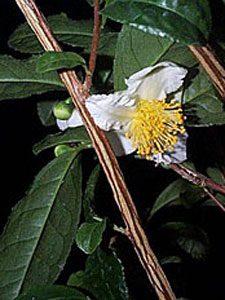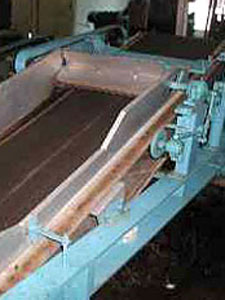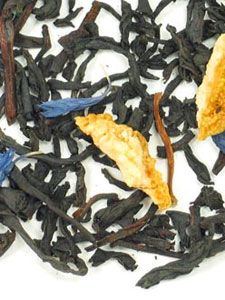The Basics of Brewing Black Tea



Most people I know are big coffee drinkers. It comes from New Jersey diner culture, from having Quick Cheks and Dunkin Donuts within a few minutes of wherever you are. It's just what we do here. We drink a lot of coffee.
It's because of this that I started with and drink a lot of black tea. Black tea is, obviously, the darkest variety of tea, and often it's the strongest—it's the closest to coffee that you're going to get. It's also the closest to what most people are used to as far as "tea" goes—we've all drunk Lipton before, and Lipton is simply black tea.
(Incidentally, you've possibly been confused or curious as to what "Orange Pekoe" is, as you've probably seen it on a teabag at some point. That has nothing to do with color or flavor or anything like that; "Orange Pekoe" is merely a classification of the leaf. It's still black tea.)
So the question is, what exactly is black tea, how do we get it, and what's so good about it?
All tea—I say this a lot but it bears repeating—is made from the same plant, one which is called camellia sinensis. Harvesting the tea—and slightly different types of leaves are used for certain different types of teas—is the easiest part. Why we get an oolong or a green as opposed to a white depends on how the leaves are processed.
Leaf processing when a black tea is desired is a 4-step process. The first step, withering, requires the leaves to be spread out and left out until they become limp and pliable.
After the leaves are withered, they are rolled—either by hand or using a special machine—which causes the leaves to release chemicals.
These chemicals, during the third step, oxidation, react with oxygen. This step is sometimes called fermentation, though it has nothing to do with alcoholic fermentation. The leaves, up until this point, have been green; during the three or four hours that the leaves are exposed to air, they turn a dark reddish-brown.
It's at this point that the final step, firing, occurs. The tea is passed through large ovens; this causes the tea to become dried out. It also halts the oxidization, and after this point you've got a nice batch of loose tea ready to be brewed.
If the tea is destined for tea bags, instead of being rolled, the leaves pass through what is called a CTC machine—short for "Cut, tear, and curl." It's a pretty descriptive name for what goes on during the process—various rollers break the withered leaf into the tiny pieces you're familiar with if you've broken apart a tea bag. Since you're reading an article produced by a gourmet tea company, I can assume that you're not a fan of cheap tea bags and that I don't need to tell you that tea produced by the CTC method is of vastly lower quality than that of a hand-rolled tea. Not that CTC produced tea does not have its advantages. For a teabag, it's ideal: small particles of tea produce a smaller and darker brew much more quickly than a full tea leaf.
When you get your tea, you are going to want to use about a teaspoon per eight ounces of water—if you're using one our snazzy ingenuiTEAs (all the cool kids do!), you'll use about two teaspoons total. I usually put in enough to just cover the filter. Add some boiling water and steep for about five minutes. While no tea benefits from oversteeping, you run into the highest danger of bitterness with a black tea, as it contains the highest degree of tannins. After your five minutes or so, you'll get a nice, dark brew. If you like—and certain tea purists will take out hits on me for saying this—you can add a little milk and sugar or honey—black teas can handle them the best of any kind of tea. If you're in the mood to be traditional English teatime, you'll add the milk first. Personally I add it afterwards, so don't feel bad if you do as well. If you're finding your tea bitter, you probably might want to add milk, as it will absorb some of the tannins and make the taste more pleasant. The caffeine in each 8-oz cup of tea should have around 40 milligrams of caffeine in it, so you'll get that nice awakey feeling after a cup.
So now that you know how to brew your tea, what kind should you try? I'm going to suggest the first tea of Adagio's that I've tried, which is Yunnan Gold. It's one of my favorites and it's my "default" tea—when I can't tell what sort of tea I feel like having, I'll usually reach for a Yunnan. It's got a nice peppery taste to it; it's a rich and flavorful tea, and it is one of those that tastes excellent with milk and sugar.
Earl Grey is another popular choice. The first thing you'll notice about it is a very pleasant bitterness. Earl Grey is flavored with bergamot oil (which is why it's sometimes considered a flavor tea), which comes from a type of citrus fruit. You'll notice what look like orange peels in the tea if you order it, and in fact occasionally people will worry that they've been given the wrong tea. Never fear: that's what it's supposed to look like! We add the citrus peels directly to the tea in order to give it a stronger flavoring. Try it. You'll like it.
English Breakfast is another favorite of mine, and it's likely you've tried a bagged version of it at some point. I personally really like Adagio's English Breakfast because it's got a nice smoky flavor; that turns some people off, so I'll suggest the Irish Breakfast, as it's a bit of a less intense—but no less flavorful—variation. English Breakfast usually becomes the first thing I drink in the morning—my routine in the morning is to brew a cup of that, and while I'm waiting to turn on my computer, arrange the things on my desk, and get ready to answer your e-mails!
Now you know all that there is to know about black tea—or, at least, enough to get you started. This month your homework will be to try at least six of our varieties of black tea and to write a 5-paragraph essay comparing and contrasting them. Next month, I'll be taking a look at that mysterious, less-oxidized, branch of the tea family known only as "oolong." Or as "wulong." Or as "Chinese restaurant tea." Okay. So it's got a lot of names. It's still good, and we'll get into it in-depth in June, so watch this space!
